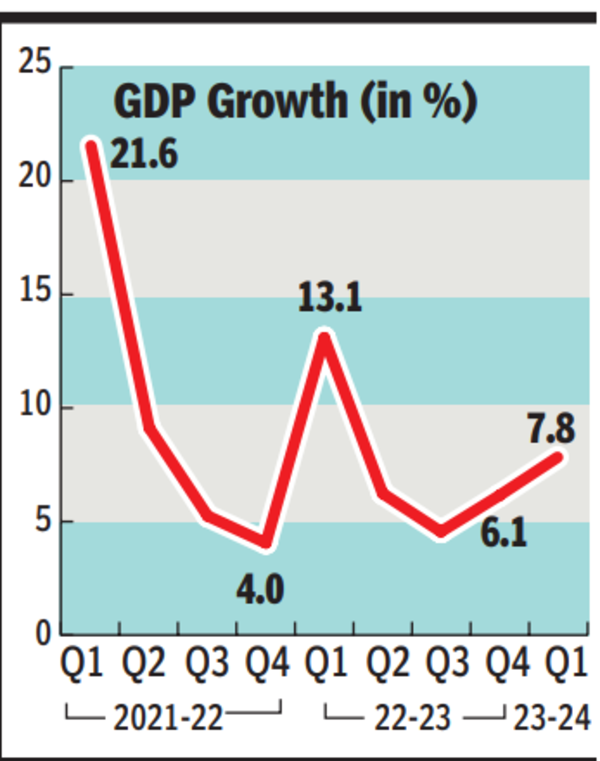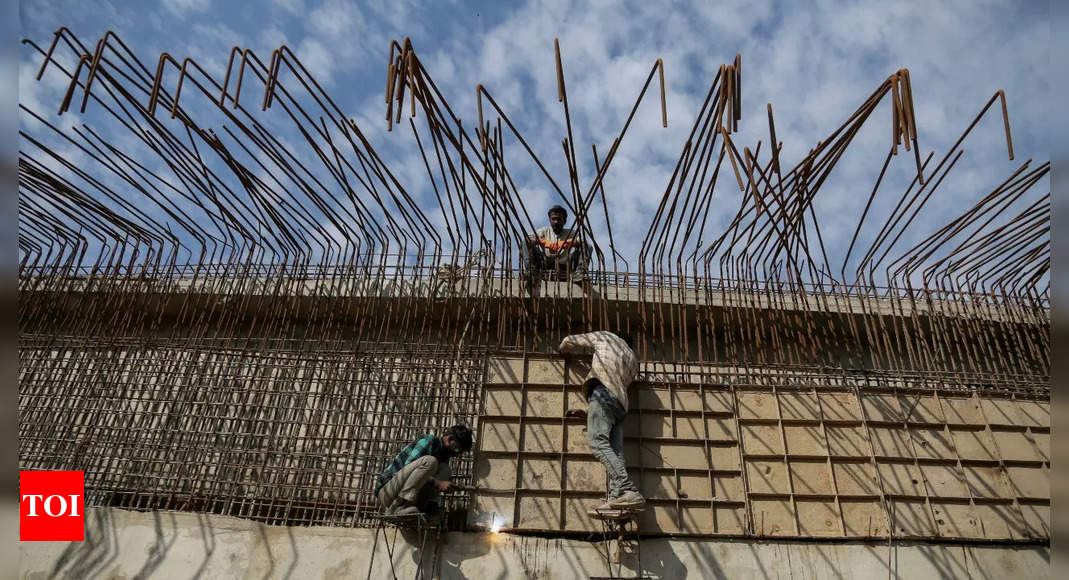NEW DELHI: The country’s economic growth in the April-June quarter of the current fiscal year touched a four-quarter high on the back of robust performances by services, farm, manufacturing and mining sectors and a favourable base, but patchy monsoon rains and a global slowdown could hurt expansion in the months ahead.
Data released by the National Statistical Office (NSO) on Thursday showed the economy grew by 7.8% in April-June — the first quarter of the 2023-24 fiscal — higher than 6.1% in the previous three-month period and lower than 13.1% in the first quarter of 2022-23, which was a recovery period from the Covid-19 pandemic. The 7.8% number is slightly lower than the Reserve Bank of India’s estimate of 8% growth for the first quarter. The Centre is confident that the economy will grow by 6.5% in the current fiscal year despite the looming risks and that India will remain the fastest-growing major economy in the world.
The government said the Indian economy remained resilient with 7.8% growth in the first quarter amid global headwinds and was boosted by double-digit growth in the services sector.

“The strength in domestic consumption outweighed the drag from global demand during Q1. Outperformance of services over industry and strong anchoring by public investments continue to dominate the overall narrative,” economic advisory QuantEco said in a note.
The services sector, which accounts for nearly 58% of the economy, grew 10.3% in the June quarter powered by a 28-quarter-high 12.2% growth in the financial, real estate and professional services sector, according to data from SBI Research.
The farm sector, which has remained strong for the past few quarters, grew 3.5% in the first quarter while the construction sector, which had held strong earlier, grew 7.9%, slower than the 16% growth in the first quarter of 2022-23.
The manufacturing sector grew 4.7% during the June quarter, lower than the 6.1% recorded in the first quarter of the previous year.
“On the expenditure side, a pick-up in private consumption was a positive development. Private consumption expenditure grew by 6%, up from a muted growth of 2.8% a quarter ago. Broadly, it was led by discretionary demand by urban consumers as reflected in healthy numbers for air and railway passenger traffic, growth in retail credit and PV sales. Some pick-up in rural demand was also witnessed during the quarter with higher growth in production of consumer non-durables and improvement in two-three-wheeler sales,” said Rajani Sinha, chief economist at ratings agency CareEdge.
Experts cautioned that the economy could face obstacles from a weak monsoon, slowing exports due to a reduced global demand and price pressures.
“Growth in the July-September quarter will be moderated by softening consumption as spiking inflation will dent discretionary spending power. For the rest of the year, headwinds from slowing global growth and lagged impact of interest rate hikes will play out. Additionally, if dry weather conditions seen in August continue in September, agricultural output could be impacted,” said D K Joshi, chief economist at ratings agency Crisil.
“That said, our current forecast of 6% GDP growth for this fiscal year could make India the fastest-growing G20 country this year,” said Joshi.
Data released by the National Statistical Office (NSO) on Thursday showed the economy grew by 7.8% in April-June — the first quarter of the 2023-24 fiscal — higher than 6.1% in the previous three-month period and lower than 13.1% in the first quarter of 2022-23, which was a recovery period from the Covid-19 pandemic. The 7.8% number is slightly lower than the Reserve Bank of India’s estimate of 8% growth for the first quarter. The Centre is confident that the economy will grow by 6.5% in the current fiscal year despite the looming risks and that India will remain the fastest-growing major economy in the world.
The government said the Indian economy remained resilient with 7.8% growth in the first quarter amid global headwinds and was boosted by double-digit growth in the services sector.

“The strength in domestic consumption outweighed the drag from global demand during Q1. Outperformance of services over industry and strong anchoring by public investments continue to dominate the overall narrative,” economic advisory QuantEco said in a note.
The services sector, which accounts for nearly 58% of the economy, grew 10.3% in the June quarter powered by a 28-quarter-high 12.2% growth in the financial, real estate and professional services sector, according to data from SBI Research.
The farm sector, which has remained strong for the past few quarters, grew 3.5% in the first quarter while the construction sector, which had held strong earlier, grew 7.9%, slower than the 16% growth in the first quarter of 2022-23.
The manufacturing sector grew 4.7% during the June quarter, lower than the 6.1% recorded in the first quarter of the previous year.
“On the expenditure side, a pick-up in private consumption was a positive development. Private consumption expenditure grew by 6%, up from a muted growth of 2.8% a quarter ago. Broadly, it was led by discretionary demand by urban consumers as reflected in healthy numbers for air and railway passenger traffic, growth in retail credit and PV sales. Some pick-up in rural demand was also witnessed during the quarter with higher growth in production of consumer non-durables and improvement in two-three-wheeler sales,” said Rajani Sinha, chief economist at ratings agency CareEdge.
Experts cautioned that the economy could face obstacles from a weak monsoon, slowing exports due to a reduced global demand and price pressures.
“Growth in the July-September quarter will be moderated by softening consumption as spiking inflation will dent discretionary spending power. For the rest of the year, headwinds from slowing global growth and lagged impact of interest rate hikes will play out. Additionally, if dry weather conditions seen in August continue in September, agricultural output could be impacted,” said D K Joshi, chief economist at ratings agency Crisil.
“That said, our current forecast of 6% GDP growth for this fiscal year could make India the fastest-growing G20 country this year,” said Joshi.
Source link

